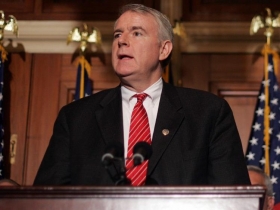How State Aid to Cities Has Plummeted
Milwaukee is getting killed by declining shared revenue, violating a century-old state agreement.
You might call Mayor Tom Barrett a victim of history.
Most major cities in America have other ways to raise revenue besides the property tax. “It’s safe to say we’re one of the only cities in America that doesn’t have another tax — an income or sales or gas tax,” Barrett notes.
Wisconsin’s leaders, however, didn’t want cities using tax rates to gain an advantage on other cities. “The idea was to prevent the balkanization of the state — let’s not have cities compete with each other based on taxes,” Barrett observes.
It was all part of the “Wisconsin Idea,” which made this a unique laboratory for democracy that originated concepts like workman’s compensation and the first state income tax in 1911 (two years before a constitutional amendment created the federal income tax). With the new revenue from the income tax, Wisconsin’s leaders decided, it would return a substantial portion of the revenue raised to localities through “shared revenue,” while prohibiting them from levying their own income or sales taxes.
This left a city like Milwaukee with two main sources of revenue: the property tax, undoubtedly the most hated tax in the state (which makes it difficult to raise) and shared revenue from the state. And that has been plummeting for years.
The decline dates back to the mid-1990s. In 1995, 53 percent of Milwaukee’s general purpose budget was paid for by shared revenue; today, just 39 percent comes from this. Most of that decline occurred in just the last decade, under governors Scott McCallum, Jim Doyle and Scott Walker. In the 1992/93 budget year, figures from the Legislative Fiscal Bureau show, 13.1 percent of the state budget went to shared revenue; by 2012/13 it accounted for just 6.3 percent of the state budget.
Today, nine years into Barrett’s service as mayor, shared revenue to Milwaukee doesn’t even pay for the police; it now falls $114 million short of paying for the police and fire department budgets.
If it had risen at the rate of inflation, that shared revenue payment of $224 million in 1995 would be $340 million today; in fact, Milwaukee now gets $218 million. That’s a drop of 36 percent in real dollars in state aid to Milwaukee.
A 2011 study by then Milwaukee Comptroller Wally Morics compared Milwaukee to nine other mid-sized cities in America and found they raised about one-quarter of their budget from other local taxes besides the property taxes. Milwaukee was the only city that got no revenue from other taxes. These other cities also got state aid, though not as much as Milwaukee. All told, Milwaukee received 17 percent less of its budget from intergovernmental aid and other taxes (besides the property tax) than these other cities. That leaves a huge gap in revenue for Milwaukee.
It’s remarkable how the mentality in Wisconsin has changed regarding state shared revenue. As recently as the mid-1980s, then-mayor Henry Maier would castigate the legislature if they dared provide less aid to the cities. There was a widespread recognition in America that cities had tremendous poverty and unique needs, and needed more help from state and federal governments, and Maier was a national leader in promoting this idea. He would bully even Democratic legislators from the city, often with great success, threatening to target them in the next election if they didn’t deliver for Milwaukee.
Maier’s successor, John Norquist, was among those legislators that Maier had tried to bully. Partly in reaction, Norquist took a different tack, arguing that “you can’t build a city on pity,” and emphasizing the value of cities and why they were a good investment. Wisconsin without Milwaukee, he’d say, would be Iowa.
Norquist also came up with a new wrinkle to reward his fiscal conservatism, successfully proposing the state “expenditure restraint program,” that upped shared revenue for cities that limited their growth in spending. That helped Milwaukee and is still part of the state shared revenue formula.
But meanwhile, the population had grown tremendously in the suburbs and the city of Milwaukee had less power in the legislature. There had always been resentment of Milwaukee outstate. “There are politicians in Wisconsin who can credit their careers to going after Milwaukee,” Barrett says. Now was the chance to go after the state’s biggest city.
Since the 1970s, state shared revenue had been “equalized,” providing a larger share to localities with more poverty and a lower tax base. But in the late 1990s, the equalization formula was dropped (while it was retained in a watered-down fashion for school aid). Pat Curley, chief of staff for Barrett, was a lobbyist for the city back then and recalls what happened: “Suburban areas and Republicans saw cities like Milwaukee and Racine benefitting more and they wanted to change that.”
Meanwhile, the state budget was getting squeezed: the state had made a commitment to pay two-thirds of the cost of the schools, and was paying ever more for corrections and Medicaid. “Local governments were not as sympathetic as schools or nursing homes,” Barrett observes.
Indeed, McCullum proposed eliminating all shared revenue, referring to local governments as “the whiners.” This set off a storm of protest from local governments which killed the idea.
But in the decade since he made that comment, the state has, little by little, year by year, gotten nearly halfway to the point McCallum proposed, as the portion of the state budget devoted to state aid has been cut in almost half.
The impact falls the hardest on cities like Milwaukee, says Kurt Witynski, assistant director of the League of Municipalities, which represents all cities and villages in the state. “All of our members have felt it,” he says. “But it has hurt the older cities like Milwaukee or Superior, Ashland or Beloit, more than places like Brookfield, which never got that much in the first place.”
Witynski is hoping the next budget will restore some of the funding. Barrett, however, worries that too many legislators don’t see the value of cities: “There has to be a recognition that cities bear a lot of the cost of metropolitan areas. People come to Summerfest or the ethnic festivals but they don’t appreciate that police protection for this is a big-ticket item.”
But the biggest problem for Barrett and Witynski may be historical. The old agreement that created state revenue sharing a century ago has largely been forgotten, even as the prohibition against local income or sales taxes remains.
“We’re not going to have a city sales or income tax, that’s not part of the discussion,” Barrett says. “But we have to have a recognition that this is the program that assures metro areas can remain strong so they continue to be economic generators and job creators.”
Short Takes
-One other potential revenue source for the city is user charges, like the fees residents pay for water or other services. But the comptroller study found Milwaukee charged 29 percent less in user charges than the nine other mid-sized cities studied.
-Given that, have you thought about raising property taxes more, I asked Barrett? “I’m interested in continuing to hold this job,” he replied.
-It’s rare I find myself in agreement with both Christian Schneider and James Causey, but both did columns in the Sunday Milwaukee Journal Sentinel Crossroads arguing in favor of legalizing recreational marijuana use. Schneider even had some nice insider jokes, suggesting that, wink wink, he might have inhaled himself on occasion. Oh Christian, you rascal. But your point is well taken. Legalization is long overdue.
Murphy's Law
-
Is Legislature Biased Against Working Class?
 Apr 4th, 2024 by Bruce Murphy
Apr 4th, 2024 by Bruce Murphy
-
Associated Press Will Decline in Wisconsin
 Mar 27th, 2024 by Bruce Murphy
Mar 27th, 2024 by Bruce Murphy
-
City Attorney Race Is Vitally Important
 Mar 25th, 2024 by Bruce Murphy
Mar 25th, 2024 by Bruce Murphy


















Question: has the cut is shared revenue to cities in Wisconsin been proportional?
related…. What is a city? Is Port Washington a city?
That does have some bearing on the issue.
One of the problems is the sheer number of local governments in Wisconsin that are competing for all that shared revenue. There is no reason for many of these local governments to have their own police forces and plowing services, and it would benefit everyone if more of them consolidated and stopped competing against each other on tax rates and attracting development. Case in point: City of Brookfield vs.Town of Brookfield.
This is a problem that both republican and democratic leaders have recognized. Perhaps it’s time to find a way to encourage more consolidation.
Every Liberal is already smoking pot, that’s why they are so nutty. End all aid to cities and concentrate on schools, with limits based on performance.
Our kids can’t read, time to demand that of the education system.
@Begonia
Interesting that you brought up the point that there are too many units of government in Wisconsin. This is a favorite of conservatives like the MMAC and The Kettle Commission that led,in many ways, to McCallum’s conclusion that he could eliminate shared revenue. Interestingly, the facts indicate that their conclusion just isn’t correct. See this study by the LGIW that indicates that while savings can be acheived through shared services, Wisconsinites not only like there government to be local, but they dont necessarily pay more for that priveledge. A little knowledge can go a long way in defeating these old, stale ( and failed) assumptions. Bruce, it may be a worthwhile subject for a future column
http://www.localgovinstitute.org/roadmap
Apologies. Here is the link
Wis. Conservative Digest,
“End all aid to cities and concentrate on schools…”, I agree whole heartedly. We need to end all aid to cities in order to vacate them as quickly as possible. They are bastions of blue that tarnish our great state. Only by forcing out those who suckle at the nipple of entitlement and live within their azure towers of handouts can we get this state back on track. Back to the days when there were men like Mayor Emil Seidel who took a brush to our fair city and cleaned up the dredges who inhabited those houses of ill repute and instituted law and order. (Our “president” could learn a thing or two from him.) We need to hold our schools and teachers accountable for their failures. After all, how can we be sure that our state’s children are getting the best educations possible if we don’t hold all teachers at all schools (both public and private) to the same exacting standard. I propose a formula such as The Bell Curve where those outliers that do not meet a strict set of intelligence criteria are banned from teaching at any institution (both public and private) throughout the state. Also, in order to make sure we’re not biasing our approach we need to bus students from cities into the surrounding schools while busing students from the outlying school systems into the cities. Only through this method can we guarantee a fair and balanced approach to teacher evaluation. Using these methods we’ll be able to uniquely determine those teachers (in the outlying schools) which can bring students (who previously were failing) up to a passing grade while simultaneously determine those teachers (from the city schools) whom cannot keep a student with passing grades at the same level. It is a veritable win-win situation that should not only push Wisconsin to the forefront of education reform but set a national standard for all cities to follow.
-KoM
I have been interested for years in the question of just how much state tax revenue is generated in the City and County of Milwaukee–not by the residents of the City and County, but by all of the economic activity generated here. I’ve never seen an article, study or report on this topic. It would be relatively easy to determine the sales tax generated within the County, but what about the income tax and other revenue streams payable solely to the state? I understand that the state tracks the income of the residents of each municipality, but what about the income earned within each municipality by all workers–residents and non-residents? Is this information available?
For example, I work at a mid-size law firm in downtown Milwaukee. Most of our highest paid employees/attorneys live in Mequon, Brookfield and other suburban communities outside Milwaukee County. They are all good people who should have the choice to live in the best place for themselves and their families. However, why shouldn’t someone who works in the City but lives in Elm Grove contribute to the cost of living and working in the same metropolitan area as the person who both resides and works in the City? Residents of neighboring counties not only benefit from working in a large metro area, but they also visit and enjoy Summerfest, the zoo, the art museum, the Marcus Center, etc. Isn’t this what shared revenue was designed to address? Wouldn’t a worker who lives in Kenosha, but works in Chicago pay Illinois income taxes? Why shouldn’t those who live outside the City and County, but work here contribute likewise.